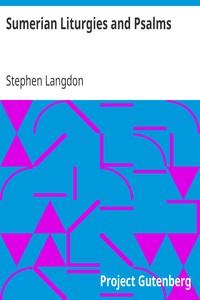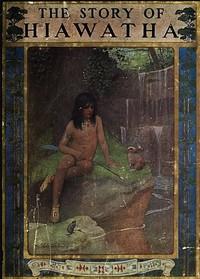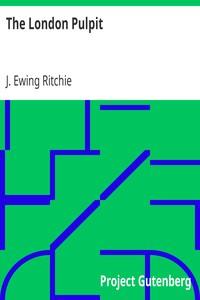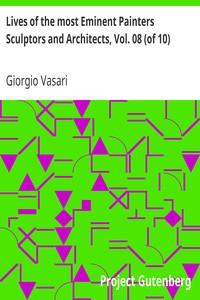Read this ebook for free! No credit card needed, absolutely nothing to pay.
Words: 48999 in 46 pages
This is an ebook sharing website. You can read the uploaded ebooks for free here. No credit cards needed, nothing to pay. If you want to own a digital copy of the ebook, or want to read offline with your favorite ebook-reader, then you can choose to buy and download the ebook.


: Sumerian Liturgies and Psalms by Langdon Stephen - Sumerian language Texts; Hymns Sumerian; Sumerians Religion
INTRODUCTION.
When our studies shall have reached the stage which renders appropriate the collection of these texts into a special corpus they will receive their due valuation in the history of religion. That they are of prime importance is universally accepted.
From the point of view of the history of religion I would assign the liturgical texts to the second group in order of importance. Surprisingly few fragments from the long canonical daily prayer services have been found. In fact, about all of the perfected liturgies such as we know the Sumerian temples to have possessed belong to the cults of deified kings. In the entire religious literature of Nippur, not one approximately complete canonical prayer service has survived. Only fragments bear witness to their existence in the public song services of the great temples in Nippur. A small tablet published in part two of this volume carries a few lines of the titular or theological litany of a canonical or musically completed prayer book as they finally emerged from the liturgical schools throughout Sumer. Long liturgical services were evolved in the temples at Nippur as we know from a few fragments of large five column tablets. The completed composite liturgies or canonical breviaries as they finally received form throughout Sumer in the Isin period were made by selecting old songs of lament and praise and re-editing them so as to develop theological ideas. Characteristic of these final song services is the titular litany as the penultimate song and a final song as an intercession. A considerable number of such perfected services exist in the Berlin collection. These were obtained apparently from Sippar. The writer has made special efforts to reconstruct the Sumerian canonical series as they existed in the age of Isin and the first Babylonian dynasty. On the basis of tablets not excavated at Nippur but belonging partly to the University Museum and partly to the Berlin collection the writer restored the greater part of an Enlil liturgy in part 2, pp. 155-167. In the present and final part of this volume another Enlil liturgy has been largely reconstructed on pages 290-306. From these two partially reconstructed song services the reader will obtain an approximate idea of the elaborate liturgical worship of the late Sumerian period. These were adopted by the Babylonians and Assyrians as canonical and were employed in interlinear editions by these Semitic peoples. Naturally the liturgical remains of the Babylonian and Assyrian breviaries are much more numerous and on the basis of these the writer was able in previous volumes to identify and reconstruct a large number of the Sumerian canonical musical services. But a large measure of success has not yet attended his efforts to reconstruct the original unilingual liturgies commonly written on one huge tablet of ten columns. Obviously the priestly schools of the great religious center at Nippur possessed these perfected prayer books but their great size was fatal to their preservation. It must be admitted that the Nippur collection has contributed almost nothing from the great canonical Sumerian liturgies which surely existed there.
Undoubtedly the most important liturgical tablet which pertains to the ordinary cults in the Nippur collection is discussed on pages 279-285. The breviary, which probably belongs to the cult of the moon-god, derives importance from its great length, its theological ideas, especially the mention of the messengers which attend the Logos or Word of Enlil, and its musical principles. Here each song has an antiphon which is unusual in precanonical prayer books of the ordinary cults. Students of the history of liturgies will be also particularly interested in the unique breviary compiled from eight songs of prostration, a lamentation for the ancient city of Ke? with theological references. This song service was popular at Nippur, for remains of at least two copies have been found in the collection. A translation is given on pages 311-323.
Nearly all the existing prayer services in the cults of the deified kings of Ur and Isin are now published and translated. The student will observe that they are all of the compiled type but that there is in most cases much musical arrangement and striving for combined effect. A few, and especially the Ishme-Dagan liturgy published as No. 1 of this part, reveal theological speculation and an effort to give the institution of god-man worship its proper place in their religion. The hymns of these cults comparatively so richly represented in this volume will be among the most interesting groups of religious texts supplied by the excavations at Nippur.
OXFORD, July 9, 1919.
LAMENTATION OF ISHME-DAGAN OVER NIPPUR. 13856
"Her population like cattle of the fields within her have perished. Helas my land I sigh."
So reads a line from the second melody.
Lines of similar character occur repeatedly in the laments of the mother goddess as she weeps for her people in the standard liturgies. In other words, the cult of the deified kings issues here into its logical result. The god man created to live and die for his people usurps the sphere of the earth mother herself. And like her he is intimately associated with the fortunes of mankind, of nature and all living creatures. The great gods and the hosts of their attendants rule over man and the various phases of the universe from afar. But the mother goddess is the incarnation of fruitful nature, the mother of man whose joys and sorrows she feels. So also in this remarkable liturgy the deified son of the great gods lives among men, becomes their patron and divine companion.
The tablet contained originally about fifty lines in each column, or 200 in all. About one-third of the first column is gone. The first melody contained at least fifty lines and ended somewhere shortly after the first line of Col. II of the obverse. It began by relating how Enlil had ordered the glory of Nippur, and then had become angered against his city, sending upon it desolation at the hands of an invader. When we take up the first lines of Obv. II we are well into the second melody which represents Ishme-Dagan mourning for fathers and mothers who had been separated from their children; for brothers who had been scattered afar; for the cruel reign of the savage conqueror who now rules where the dark-headed people had formerly dwelled in peace.
At about the middle of Obv. II begins the third melody which consists of 38 lines extending to Rev. I 19. In this section the psalmist ponders upon the injustice of his city's fate, and looks for the time when her woes will cease, and Enlil will be reconciled.
Free books android app tbrJar TBR JAR Read Free books online gutenberg
More posts by @FreeBooks

: The Story of Hiawatha Adapted from Longfellow by Longfellow Henry Wadsworth Stokes Winston Kirk Maria Louise Illustrator - Indians of North America Poetry; Hiawatha active 15th century Poetry; Iroquois Indians Kings and rulers Poetry


: The London Pulpit by Ritchie J Ewing James Ewing - Religious thought England London; London (England) Religion




